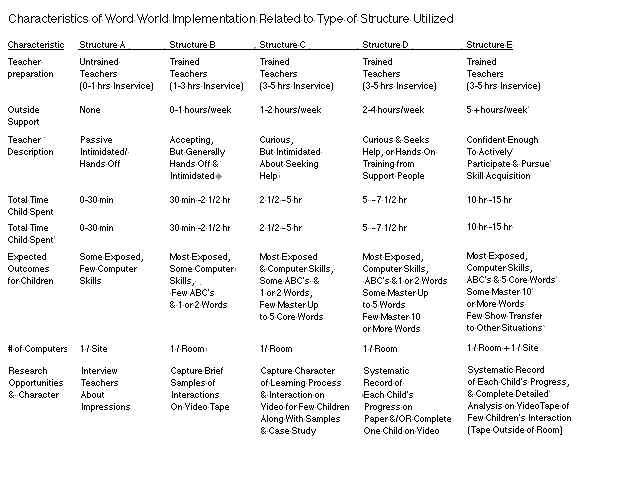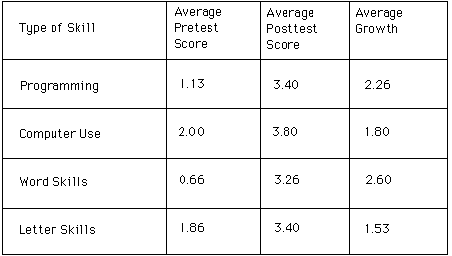resources | hopper & lawler, 1991
Hopper, M. E. and Lawler, R. W. (1991, August). Pre-Readers' Word Worlds:
Results of experiences with young children and new directions. Poster session
presented at the 1991 1991 International Conference on the Learning Sciences
(Thirteenth annual meeting of the Cognitive Science Society), Northwestern University,
Evanston, IL.
Abstract
The Purdue Headstart Apple Project has investigated ideas about the
potential impact of computer experience on pre-readers. The studies which
have resulted from this project provide a description of the range of ways
microcomputer technology can be successfully implemented in preschool
settings for both instructional purposes and learning research. The results
of these studies also illustrate specific relationships between the investment
of human resources and the ability of Logo Word Worlds
to successfully function as both a motivating method for introducing young
children to reading and as a tool for learning research.
Acknowledgement
We would like to thank Purdue University and the External Research Program of
Apple Computer for making this research possible through provision of hardware and funding for graduate
student assistance. We would also like to thank the teachers at Headstart, who provided continuing support,
patience and enthusiasm for our project: Janie Farrell, Bea Figueora, Dawn Flynn,Teresa Glass,
Barbara Kennedy, and Susan Strong. Of course, we will also never forget all the children who participated
in our project.
Introduction
Logo Word Worlds are computer-based learning environments,
or microworlds, for inductive learning of language. Children create and manipulate
computer animated objects on the display screen by using words of a natural language.
Word worlds are in essence language oriented "task domains " or "problem spaces"
which provide virtual, streamlined experience to building the simplest model of
language which a reader needs as an acceptable entry point to beginning knowledge of reading.
(Lawler, Niang & Gning, 1983)
The Goals of the Project
The goal of the Purdue Headstart Apple Project was to explore the impact of computer experience
with Logo Word Worlds on pre-readers. This project has been carried
out at Purdue University and a Headstart location in Lafayette, Indiana. The resulting research data,
obtained from pilot projects and detailed case studies, demonstrates the feasibility of implementing
microcomputer technology in preschool settings for both instruction and learning research.
The data also show that word worlds have the potential to be a refreshingly motivating and
effective method for introducing young children to pre-reading skills, given sufficient
investments of time and resources. Our investigations of word worlds have included the
following efforts:
- Exploration of uses of Apple Sprite Logo word worlds with pre-readers in Headstart.
- Development of word worlds for use in languages other than English using Apple Sprite Logo
as well as other systems available in other countries.
- Recreating word world facilities on newer software and hardware platforms currently
available on the market.
Exploring Word Worlds with Pre-Readers in Headstart
Goal: Exploration of uses of Apple Sprite Logo word worlds with pre-readers in Headstart.
The word worlds at the Headstart site were created and implemented using Apple Sprite
Logo on Apple IIe computers. The work in the Headstart community has produced a systematic
range of outcomes related to the type of structure used to implement word worlds.
These are represented in Table 1.

The graphic shows different structures used for implementation have produced varying acceptance by teachers,
changes in children's Computer Skills, ABC's or "Letter Knowledge", and Word Knowledge.
Structures A, B, and C occured during the research project in Lafayette. The information for
Structure D was obtained from a telephone interview with researcher, Elizabeth Legenhausen,
about her experiences during a formal experimental study she carried out at urban and rural
research sites in Baltimore, Maryland, to explore the impact of word worlds on the school
readiness skills of preschoolers (Legenhausen, 1990).
The information for Structure E was not based on actual data, because no studies have been
performed in which all children received more than ten (10) hours of instruction with word worlds,
so the information for Structure E was extrapolated using the rest of the table, and thus is hypothetical.
The table demonstrates that as more resources were introduced into the environment, there were increasing
benefits in terms of teacher involvement, children's progress (see Table 2), and research opportunities.

Table 2 Progress of the children who used the Word Worlds
Developing Word Worlds in Languages Other Than English
Goal: Development of word worlds for use in languages other than English using
Apple Sprite Logo as well as other systems available in other countries.
A second goal of our project has been to show that word worlds are simple, powerful,
and flexible materials for cross language instruction. The procedural structure of Logo
makes translation between languages a simple process of renaming procedures by teachers
of young children, or a useful language learning exercise for older children.2 In addition
to working with the Headstart research described above Robert Lawler worked with researcher
Miriam Fletcher to create Spanish versions of word worlds, and researchers Xiaodong Lin and
Shiou Wen Yeh to create Japanese and Chinese word worlds. Most of this development work
has also taken place using the Apple Sprite Logo system. These programs have begun to be
used successfully in local schools to explore the use of word worlds introducing other
languages to English speaking students, for easing the process of introducing ESL students
to English in the United States, and for facilitating multiple language learning in both
the United States and other countries.
Recreating Word Worlds on Newer Platforms
Goal: Recreating word world facilities on newer software and hardware platforms
currently available on the market.
Although most of the work carried out at Headstart and Purdue used Apple Sprite Logo,
a third goal of our project has been to explore ways to utilize Macintosh II computers
to emulate the function of the Apple Sprite Logo system. When Logo was first made available
to the education community, the implementation system was the TI-99 microprocessor. That system,
and its follow-on, the Apple Sprite Logo system, were ahead of their time, and have not been
commercially successful in the United States for extraneous reasons. While these systems have
remained available to researchers in this country, there has been no way to make word worlds
widely available to schools outside of the research community.
This project used four different approaches to making word worlds using Macintosh applications
to emulate the Apple Sprite Logo system. Student Bob Sikorski experienced limited success using
first Object Logo and then the Lingo Language in Macromind Director to create small word worlds.
Researcher Mary Hopper also experienced limited success creating a small demonstration word world
within a HyperCard environment. The most promising effort at creating a word world on a Macintosh
was achieved by graduate student Carl Haynes, who was able to create an excellent demonstration
word world using Think Pascal.
Further Directions
Although this project has been oriented towards practical issues, this work also has implications
for understanding language learning and communication across different cultures. These concerns will
guide future investigations which will include a project to explore how word worlds can be used with
older children (kindergarten, first grade), and an international project for the cross cultural
adaptation of word worlds to provide more in depth study of word world use in different languages.
References
(Lawler, 1982) Lawler, R. (1982) Designing computer-based microworlds. BYTE, 8, 138-155.
(Lawler, Niang & Gning, 1983) Lawler, R., Niang, M., & Gning, M. (1983).
Computers and literacy in traditional languages. UNESCO Courier, March. S.E.I., New York.
(Legenhausen, 1990) Legenhausen, E. (1990). The Effectiveness of
instruction using a microcomputer equipped with LOGO microworlds on the acquisition of school readiness
skills by preschool children. Unpublished Doctoral Dissertation, Johns Hopkins University, Baltimore, MD.
© Mary E. Hopper [MEHopper] |
MEHopper@TheWorld.com
[posted 01/01/01 | revised 02/02/02]

